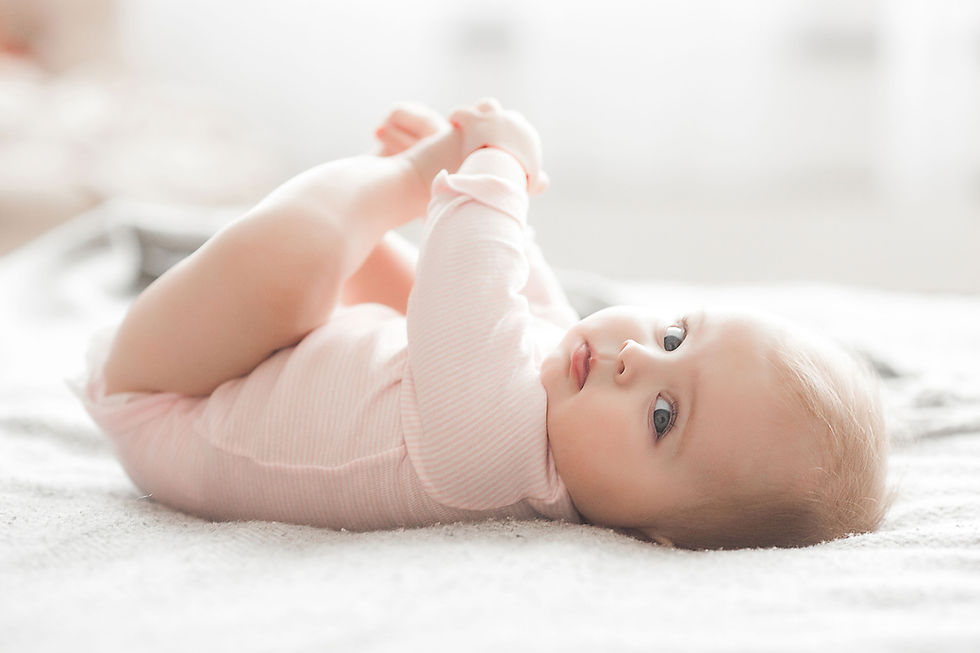Essential Safe Sleep Tips for New Parents
- shippeekn
- Oct 16
- 3 min read
If you’ve ever found yourself staring at your baby while they sleep — checking their breathing, adjusting their blanket, wondering if everything’s “safe” — you’re definitely not alone.Newborn sleep is beautiful and a little nerve-wracking. Every parent wants their baby to be cozy, rested, and most importantly, safe.
Let’s talk about the safe sleep basics every parent should know — simple, evidence-backed steps that help your baby sleep safely and help you rest a little easier, too.

ABC's of Safe Sleep
When it comes to baby sleep, remember these three letters: A-B-C
A – Alone B – On their Back C – In a Crib or Bassinet
That’s the foundation of every safe sleep setup. Here’s what each one means:
Alone: Your baby should have their own sleep space — no pillows, blankets, stuffed animals, or bumpers. Just your baby on a firm mattress with a fitted sheet.
Back: Always place your baby on their back for sleep, for naps and nighttime. This position greatly reduces the risk of SIDS.
Crib/Bassinet: Use a flat, firm sleep surface that meets current safety standards. Avoid inclined sleepers or couches (even if baby drifts off there for a second!).Creating a Safe Sleep Environment
What a Safe Sleep Space Looks Like
Think simple and firm — not Pinterest-perfect.
A safe sleep setup includes:
A firm, flat mattress with a snug-fitting sheet
No loose bedding or pillows (sleep sacks are a great alternative!)
A smoke-free environment
Room-sharing for at least the first 6 months
Room-sharing means baby sleeps in your room — close enough to reach, but in their own bassinet or crib. It makes nighttime feedings easier and keeps baby safer.

What to Avoid
It can be so tempting to use cozy blankets, positioners, or cute accessories — but some popular items aren’t actually safe for newborn sleep. Skip anything that includes:
Bumpers, wedges, or sleep positioners
Stuffed animals or pillows in the crib
Weighted blankets or hats
Inclined sleepers or bouncers for naps
If it’s not flat and firm, it’s not meant for sleep — even if your baby seems to love it for a quick snooze.

Dress Baby Right for Sleep
Temperature is a big piece of safe sleep. Babies sleep best when they’re comfortably warm, not bundled.
Dress baby in one more layer than you’re wearing.
Sleep sacks are a perfect way to keep them cozy without loose blankets.
Keep the room between 68–72°F (20–22°C) if possible.
A good rule of thumb: if you’re comfortable, baby probably is too.
Bonus Tips for Safer, Better Sleep
Offer a pacifier for naps and bedtime (once feeding is well established — it can help reduce SIDS risk).
Avoid overheating — sweaty skin or damp hair means baby is too warm.
Always supervise tummy time — that’s for play, not sleep!
Keep smoke away from baby’s sleep area.
You’re Doing Great
Safe sleep isn’t about perfection, it’s about progress and awareness. The goal is to create a safe space where both you and your baby can rest easier. And remember: no one does it perfectly all the time. What matters is that you’re learning, caring, and showing up for your baby. That’s what makes you a great parent.
If you’re in the Denver area and want hands-on help setting up your baby’s sleep space or creating healthy sleep habits from the start, I’d love to help. I offer newborn sleep and postpartum support designed to give you confidence and rest. Let’s connect.
_edited_edite.png)



Comments